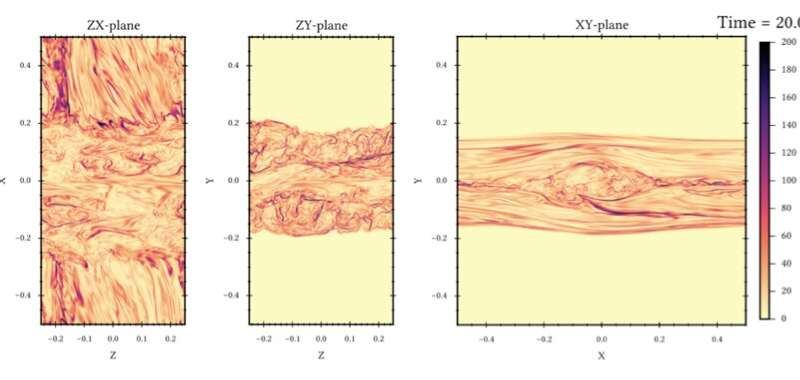Fast reconnection in turbulent media

Solar flares, similar to many other astrophysical energetic processes, are related to magnetic reconnection. During these events magnetic energy is transferred from other forms of energy, mostly heat and energetic particles. Traditionally, the goal of various models of magnetic reconnection was to explain the rate of this energy transfer. However, the flares are just one of the processes that involve magnetic reconnection. If one imagines any complex motion in a highly conducting medium, the magnetic field, which is assumed to be frozen into the fluid as a result of the famous Alfven (1942) theorem, should create intersections of "knots" that have to arrest the motion of the fluid, unless the magnetic reconnection is fast. Turbulent motions, that are ubiquitous for high Reynolds number astrophysical fluids, present a typical example of such complex fluid motions.
The analytical theory presented in Lazarian & Vishniac (1999, henceforth LV99) testify that 3-D MHD turbulence can make the magnetic reconnection fast, solving problems related both to flares and to explaining the dynamics of turbulent flows. The numerical difficulties associated with the simulations of reconnection within 3-D turbulent flows impeded the progress of testing of the predictions of the turbulent reconnection theory. As a result, models that required only 2-D numerical simulations, i.e. the plasmoid reconnection (Loreiro et al 2007), became widely used and compared with observations. The situation has changed recently as higher resolution numerical simulations became available making testing of 3-D reconnection feasible.
A recent review in Lazarian et al. (2019, henceforth LX19) summarizes the theoretical, numerical and observational progress achieved in the field of 3-D turbulent reconnection. Numerical simulations of the scale 2048x8982x2048 are illustrated in Figure 1. The large scale of the simulations is required to have the outflow thick enough to get it turbulent. Those simulations testify that in 3-D the growth rate of the plasmoid instability is significantly less than of the Kelvin-Hemholtz instability of the outflow. Therefore, in 3-D the magnetic reconnection mediated by plasmoids can be expected only at the initial stage of the reconnection, before the turbulent outflow is formed.
For a given level of turbulence, the numerical simulations show the rate of reconnection that is expected from the LV99 theory. As for flares involving reconnection, they have a natural explanation within the turbulent reconnection model. According to the model, the level of magnetic reconnection increases with the level of turbulence. The increase of the matter outflow increases the level of the turbulence and this, in turn, increases further the reconnection rate. This is a runaway process.
One of the most dramatic predictions of the turbulent reconnection theory is the flux freezing violation in turbulent fluids, the effect that was also successfully demonstrated numerically.
The role of the plasma effects is a hotly debated issue in the literature with simulations that account for plasma effects usually showing reconnection rates faster than those in MHD limit. In LX19 theoretical arguments on the decreasing importance of the plasma effects with the increase of the length of the turbulent reconnection region are supported by numerical simulations. The PIC simulations presented in the review provide results that are consistent with those obtained with MHD simulations.
LX19 contains a list of observations that support the turbulent reconnection theory. Those include both solar observations, solar wind measurements, data on the Parker spiral, etc.
Due to the progress of 3-D numerical simulations, the model of turbulent reconnection has demonstrated its validity. The model has a set of predictions that can be tested observationally. Studies of solar reconnection, see Chitta & Lazarian (2019), provide a good way to test the predictions of the turbulent reconnection theory.Mix master: Modeling magnetic reconnection in partially ionized plasma
More information: Based on a recent paper Lazarian et al, Physics of Plasmas, 2020: DOI: doi.org/10.1063/1.5110603
No comments:
Post a Comment